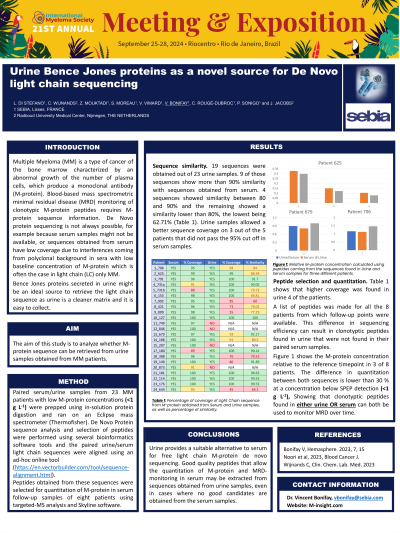MRD and Biomarkers
Urine Bence Jones proteins as a novel source for De Novo light chain sequencing
P-167: Urine Bence Jones proteins as a novel source for De Novo light chain sequencing
Thursday, September 26, 2024

- LD
Luciano H. Di Stefano, PhD (he/him/his)
Mass Spectrometry Expert
SEBIA, France
Introduction: Multiple Myeloma (MM) is a type of cancer of the bone marrow characterized by an anormal growth of the number of plasma cells, which produce a monoclonal antibody (M-protein). Blood-based mass spectrometric minimal residual disease (MRD) monitoring of clonotypic M-protein peptides requires M-protein sequence information. De Novo protein sequencing is not always possible, for example because serum samples might not be available, or sequences obtained from serum have low coverage due to interferences coming from polyclonal background in sera with low baseline concentration of M-protein which is often the case in light chain (LC) only multiple myeloma (MM). Bence Jones proteins secreted in urine might be an ideal source to retrieve the light chain sequence as urine is a cleaner matrix and is easy to collect. The aim of this study is to analyze whether M-protein sequence can be retrieved from urine samples obtained from MM patients.
Methods: Paired serum/urine samples from 23 MM patients with low M-protein concentrations were prepped using in-solution protein digestion and ran on an Eclipwse mass spectrometer (Thermofisher). De Novo Protein sequence analysis and selection of peptides were performed using a several bioinformatics software and the paired urine/serum light chain sequences were aligned using an ad-hoc online tool (https://en.vectorbuilder.com/tool/sequence-alignment.html). Peptides obtained from these sequences were selected for quantitation of M-protein in serum follow-up samples of eight patients using targeted-MS analysis and Skyline software.
Results: LC sequences were obtained in 19 out of 23 urine samples. 9 of those sequences showed more than 90% similarity with the sequences obtained from serum, including 1 sequence with 100% similarity. 4 sequences showed between 80 and 90% similarity and the remaining showed a similarity lower than 80%. Of this challenging cohort with low M-protein concentrations, we were able to identify clonotypic peptides from all 19 LC sequences. 8/23 patients had follow up serum samples that were used to monitor the clonotypic peptide found in urine and quantify the LC. The clonotypic peptides of 4 of these patients were only obtained from the urine samples.
Conclusions: Urine provides a suitable alternative to serum for free light chain M-protein de novo sequencing. Good quality peptides that allow the quantitation of M-protein and MRD-monitoring in serum may be extracted from sequences obtained from urine samples; even in cases where no good candidates are obtained from the serum samples.
Methods: Paired serum/urine samples from 23 MM patients with low M-protein concentrations were prepped using in-solution protein digestion and ran on an Eclipwse mass spectrometer (Thermofisher). De Novo Protein sequence analysis and selection of peptides were performed using a several bioinformatics software and the paired urine/serum light chain sequences were aligned using an ad-hoc online tool (https://en.vectorbuilder.com/tool/sequence-alignment.html). Peptides obtained from these sequences were selected for quantitation of M-protein in serum follow-up samples of eight patients using targeted-MS analysis and Skyline software.
Results: LC sequences were obtained in 19 out of 23 urine samples. 9 of those sequences showed more than 90% similarity with the sequences obtained from serum, including 1 sequence with 100% similarity. 4 sequences showed between 80 and 90% similarity and the remaining showed a similarity lower than 80%. Of this challenging cohort with low M-protein concentrations, we were able to identify clonotypic peptides from all 19 LC sequences. 8/23 patients had follow up serum samples that were used to monitor the clonotypic peptide found in urine and quantify the LC. The clonotypic peptides of 4 of these patients were only obtained from the urine samples.
Conclusions: Urine provides a suitable alternative to serum for free light chain M-protein de novo sequencing. Good quality peptides that allow the quantitation of M-protein and MRD-monitoring in serum may be extracted from sequences obtained from urine samples; even in cases where no good candidates are obtained from the serum samples.